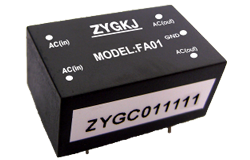소식
Exploring the Efficiency and Performance of Bidirectional DC-DC Converters
저자: ZYG 전원 모듈 Time: 2023-7-11
Introduction:
Bidirectional DC-DC converters have gained significant attention in recent years due to their ability to efficiently transfer power bidirectionally between two different DC voltage sources. These converters are crucial in various applications, including renewable energy systems, electric vehicles, and energy storage systems. This article aims to explore the efficiency and performance of bidirectional DC-DC converters, shedding light on their advantages, challenges, and potential improvements.
1. Working Principle of Bidirectional DC-DC Converters:
Bidirectional DC-DC converters, also known as buck-boost converters, use power semiconductors to convert DC voltage from a source to a desired voltage level. These converters can work in both step-up (boost) and step-down (buck) modes, allowing power to flow in either direction. By employing appropriate control algorithms, bidirectional converters enable efficient power transfer between multiple sources.
2. Advantages of Bidirectional DC-DC Converters:
2.1. Energy Efficiency: Bidirectional converters ensure efficient power transfer, minimizing energy losses during conversion. This feature is particularly crucial in renewable energy systems, where energy conservation is paramount.
2.2. Improved Stability: Bidirectional converters offer improved stability compared to unidirectional converters by allowing the transfer of power between different DC voltage sources.
2.3. Enhanced Power Flow Control: With bidirectional converters, power can be regulated and distributed appropriately, facilitating optimal power flow management in complex systems.
3. Challenges and Limitations:
3.1. Voltage and Current Stresses: Bidirectional converters may experience increased voltage and current stresses during operation, which can result in reduced efficiency and reliability.
3.2. Control Complexity: Effective control algorithms are essential for bidirectional converter operation. However, designing and implementing these algorithms can be challenging due to their complexity.
3.3. Electromagnetic Interference (EMI): Bidirectional converters can introduce high-frequency noise and EMI, which can impact the performance of other electronic components in the system.

4. Recent Developments and Improvements:
4.1. Soft-Switching Techniques: Implementing soft-switching techniques in bidirectional converters can reduce voltage and current stresses, improving overall efficiency and reliability.
4.2. Advanced Control Strategies: Advanced control strategies, such as predictive control and model-based algorithms, can enhance bidirectional converter performance and stability.
4.3. Integrated Power Modules: Integration of power semiconductor devices with other passive components can minimize parasitic elements, reducing EMI and improving overall system efficiency.
5. Conclusion:
Bidirectional DC-DC converters play a crucial role in various applications, providing efficient power transfer between multiple DC voltage sources. Despite the challenges and limitations, recent developments in soft-switching techniques, advanced control strategies, and integrated power modules have significantly improved the efficiency and performance of bidirectional converters. Further research and development efforts are needed to optimize these converters for various emerging applications, ensuring a sustainable and efficient power transfer in the future.
이전의: Introducing the SP Series AC DC Converter: Unleashing Efficient Power Conversion
다음: Bidirectional DC-DC Converter: The Future of Efficient Energy Conversion
관련 정보
-
2023-8-29
ZP Series AC DC Converter: Efficient Power Conversion at Your Fingertips
Reliable power conversion is essential for various electronic devices and systems. Whether it is for industrial, commercial, or residential applications, having an efficient AC DC converter is crucial to ensure optimal performance and energy efficiency. Introducing the ZP Series AC DC Converter, a cutting-edge solution that provides efficient power conversion like never before. Designed to meet the ever-growing demands of the industry, the ZP Series AC DC Converter offers a wide range of features and benefits that make it a top choice for engineers and designers. With its compact size and high power density, this converter can be easily integrated into various applications without compromising space or performance. One of the key advantages of the ZP Series AC DC Converter...
세부 정보보기 -
2024-1-3
Exploring the AC/DC 5V Power Supply Module and Its Versatile Applications
The AC/DC 5V Power Supply Module is a crucial component in many electronic devices. It converts the alternating current (AC) from the power source into a direct current (DC) at a stable 5V output. This module plays a vital role in providing power to various electronic circuits and devices such as microcontrollers, sensors, and integrated circuits. Features and Specifications: The AC/DC 5V Power Supply Module comes with several features and specifications that make it highly efficient and reliable. Some of the noteworthy features include: 1. Input Voltage Range: The module is designed to accept a wide range of input voltages, typically ranging from 90V to 240V AC. This allows it to be used with different power sources worldwide. 2. Output...
세부 정보보기 -
2023-7-9
Bidirectional DC-DC Converter: A Solution for Efficient Energy Conversion
Introduction In recent years, the demand for efficient energy conversion has been on the rise due to the increasing use of renewable energy sources and the need for energy storage systems. One key component in achieving efficient energy conversion is the bidirectional DC-DC converter. This article aims to explore the benefits and applications of bidirectional DC-DC converters in various industries. What is a Bidirectional DC-DC Converter? A bidirectional DC-DC converter is an electronic device that allows for the conversion of electrical energy between two DC voltage levels in either direction. It enables power flow in both forward and reverse directions, making it suitable for applications that require energy storage, such as electric vehicles, renewable energy systems, and grid-connected systems. Benefits...
세부 정보보기 -
2023-3-6
Understanding the Role of AC-DC Converters in China’s Renewable Energy Industry
The rapid growth of China's economy has led to an increase in energy demand, making the development of renewable energy sources a priority for the country. Renewable energy sources, such as wind and solar power, require power electronic devices, including AC-DC converters, to convert the energy from DC to AC for use in homes and businesses. In this article, we will discuss the role of AC-DC converters in China's renewable energy industry and the impact of this industry on the country's economy. What are AC-DC Converters? AC-DC converters are power electronic devices that convert AC power to DC power. These devices are used in a wide range of applications, including renewable energy systems, consumer electronics, and industrial automation. In...
세부 정보보기 -
2023-7-22
24V AC to DC Converter made in china: Efficient and Reliable Power Conversion Solution
Introduction: In today's technologically advanced world, the need for efficient and reliable power conversion solutions is crucial. One such solution that has gained immense popularity is the 24V AC to DC converter. This converter plays a vital role in converting alternating current (AC) power into direct current (DC) power, making it suitable for various applications in industries, households, and other sectors. In this article, we will delve deeper into the features, benefits, and applications of the 24V AC to DC converter, highlighting its efficiency and reliability. Features: The 24V AC to DC converter is equipped with several distinctive features that set it apart from other power conversion solutions. Firstly, it has a wide input voltage range, allowing it to accommodate...
세부 정보보기 -
2023-4-13
An AC-DC converter, also known as a rectifier, is an electronic device that converts alternating current (AC) to direct current (DC). This conversion is necessary because many electronic devices require DC power to operate, while the electricity supplied by the power grid is AC power. The AC-DC converter works by using a diode or a group of diodes to control the flow of electricity. A diode is an electronic component that allows electricity to flow in only one direction. By using a diode or a group of diodes, the AC-DC converter can convert the AC power to a pulsating DC power. However, pulsating DC power is not suitable for most electronic devices because it is not constant. To make the...
세부 정보보기


















